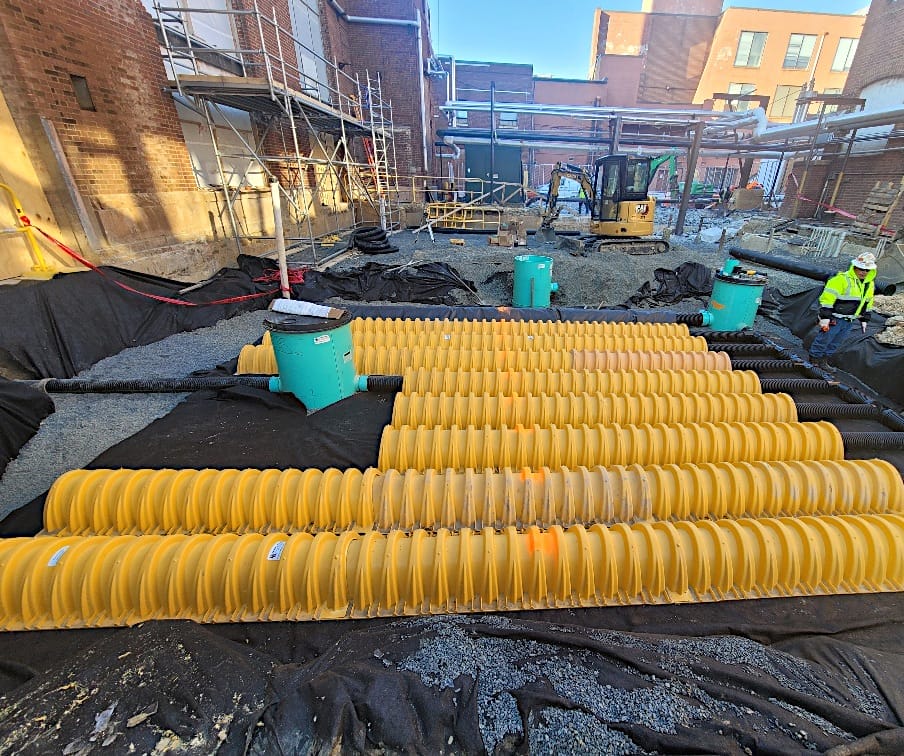When it rains, natural ground slows the rate of flowing water into streams and rivers. Water droplets must pass through layers of soil, stones, tree roots, and other obstacles before entering watercourses.
However, this process happens much faster in urbanized areas. Water from rainstorms flows rapidly over impermeable surfaces, reducing the time between the storm and flood peaks and increasing the risk of flooding. Moreover, surface runoff in commercialized areas can cause additional water pollution as flood water collects synthetic objects in the urban landscape and transports them downstream.
Most developments use drainage systems to catch and store excess water and release it slowly back into watercourses at a natural flow rate. However, these solutions don’t work well on steep terrain (because of the gradient) or when there is limited space because of dense urbanization.
In these situations, property owners use underground detention systems. These subterranean storage facilities capture stormwater from surface areas and store it out of sight until they can release it.
How Do Underground Detention Systems Work?
Above-ground stormwater management systems collect and release water in a basin over time. As you might expect, underground detention does the same, but underground.
For example, during a storm or snow melt, water flows towards a catch basin or manhole. Then, it flows down a conveyance system into an underground reservoir for storage.
The underground reservoir has another pipe at the bottom that acts like the drain on a bathtub, allowing water to flow back into natural watercourses. Engineers designed this outlet pipe to enable authorities to adjust the flow rate to match what would happen naturally. The goal is to release storm waters into the environment at the same rate as if the above development never existed.
Why Use Underground Detention Systems?
Hopefully, the justification for underground detention systems should be clear by now. These engineering projects enable builders to construct developments on steep land or in heavily built-up areas with the same stormwater run-off characteristics as regular land. Developers can use them to ensure new projects will not increase flood risk and jeopardize local communities.
Another benefit of underground detention systems is aesthetics. Unlike their above-ground counterparts, engineers hide them from view, improving the look of an area.
Installing underground detention systems is also essential for regulatory compliance. Proper stormwater management is mandated under the federal Clean Water Act.
And finally, these systems can be cost-effective over the long term because they require less land. Future developments do not need to take above-ground drainage systems into account.
Why Don’t Developers Always Use Underground Detention Systems?
Given all the benefits, you might ask why developers don’t use them all the time. The main reason is the price. While underground detention systems are cost-effective in some situations, it doesn’t make sense to use them in all.
For example, constructing them is more labor-intensive than regular above-ground drainage solutions. Building them requires excavation, drainage, and pipe networks to mimic nature.
Regulations also play a role. Authorities require some underground detention systems to have an open vault placed on a layer of sand to control pollution. Developers must install this additional layer to improve discharge quality, which can increase costs.
Moreover, the success of such systems in steep or heavily urbanized areas depends on local subterranean conditions. For example, you need the right soil type, and the groundwater table elevation must be at the right level for the passive sand filtering system to work.
Engineers sometimes design underground detention systems with pretreatment devices. These remove any unwanted objects, reducing reliance on subterranean sand filtering. However, these systems add to the cost because they require additional engineering. Building filters is significantly more complex than letting water flow into underground chambers by the force of gravity alone.
Should You Use Underground Detention Systems?
As we have seen, there are two situations where underground detention systems make sense:
- When you need to manage stormwater runoff on steep terrain
- When you can’t manage stormwater in a heavily urbanized environment
The goal of these systems is to ensure water enters natural watercourses in the way nature intended. As the name implies, detention systems prevent water from running quickly over hard surfaces into streams and rivers in a way that could cause flooding.
The downside of this type of stormwater management is the upfront cost. Creating detention systems requires digging, excavation, permits, heavy installation, pipework, and filtering apparatus. As always, it is a question of whether the benefits outweigh the costs. If you require assistance with the construction, maintenance, or inspection of underground detention systems, call Muller at 703-560-4040 or contact us through our website for more information.

